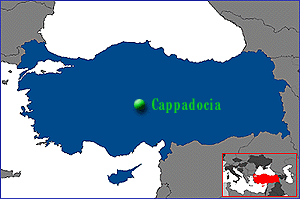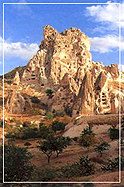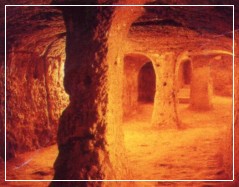


Kapadokya
The name of the ancient province in central Anatolia. The irresistible region is created through violent eruptions of the volcanoes Mt. Erciyes (3,916 m.) and Mt. Hasan (3,268 m.) three million years ago. Places which are visited most in the region are : The Göreme Open -air museum with its carved churches, the Ihlara Valley, the underground cities of Kaymaklı or Derinkuyu, the fairy chimneys, Avanos with its handicrafts, Zelve and Ürgüp.
The Taurus mountains, which are technically part of the Alpine chain, in their creation 60 million years ago, caused the warping of the Anatolian plateau. The resulting volcanoes, including the spectacular Mount Erciyas and Mount Hasan, produced the tuff from which the unique landscape of Cappadocia is formed.
There is no historical record of activity from these ancient volcanoes (and they certainly won’t interrupt your holiday) but there are three surviving memorials, although it is likely that these were created by people who had heard about the eruptions through folk history rather than having actually witnessed it themselves. One of the wall paintings in Çatalhöyük (which is incidentally one of the oldest paintings known to archaeology) shows an eruption as does an ancient engraved coin from Caesarea (Modern Kayseri). The remains of a Persian temple dedicated to fire near Mount Erciyas show that this volcano was once regarded as sacred.
It took millions of years for the ash from these volcanoes to form a layer of tuff, covered in places by a further layer of basalt lava. The basalt ultimately cracked and split under attack from the weather and rainwater seeped down through the cracks and splits to slowly erode the tuff itself. The natural effects of alternating very hot and very cold weather and the rain and the wind breaking down the rock’s resistance caused (and continues to cause) the emergence of the tall cones of tuff capped by hard basalt which the Turks call Fairy Chimneys.
Where there is no basalt layer to protect the tuff lovely valleys have been formed connected to the plateau by steep canyons of andesite and basalt. The canyons of Soğanlı and Ihlara are particularly stunning examples, Ihlara canyon being 650 feet in depth in some parts.
The valleys are sheltered and fertile with an almost temperate climate. The tuff is easily worked and, for milennia, has provided dwellings and and storerooms, both above and below ground, for smallholders. Despite it’s increasing popularity with visitors, Cappadocia is very much home to small farmers who can still be seen every day tending their orchards, vineyards and field crops and riding their donkeys home to their cave houses.
Source:
‘A Complete Guide to Cappadocia’ ISBN 975 7672 106 Published by the Cappadocia Tourism Promotion Foundation Nevşehir Turkey.
No comments:
Post a Comment